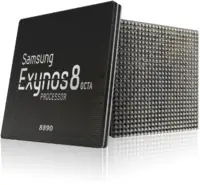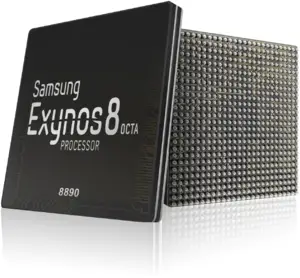| Edit Values | |
| Exynos 8 Octa | |
 | |
| General Info | |
| Designer | Samsung |
| Manufacturer | Samsung |
| Model Number | 8890 |
| Market | Mobile |
| Introduction | November 12, 2015 (announced) February 21, 2016 (launched) |
| General Specs | |
| Family | Exynos |
| Series | Exynos 8 |
| Frequency | 2,300 MHz, 1,600 MHz |
| Turbo Frequency | 2,600 MHz |
| Turbo Frequency | 2,600 MHz (1 core), 2,600 MHz (2 cores), 2,300 MHz (3 cores), 2,300 MHz (4 cores) |
| Microarchitecture | |
| ISA | ARMv8 (ARM) |
| Microarchitecture | Mongoose 1, Cortex-A53 |
| Core Name | Exynos M1, Cortex-A53 |
| Process | 14 nm |
| Technology | CMOS |
| Word Size | 64 bit |
| Cores | 8 |
| Threads | 8 |
| Max Memory | 4 GiB |
| Multiprocessing | |
| Max SMP | 1-Way (Uniprocessor) |
| Succession | |
Exynos 8 Octa (8890) is a 64-bit octa-core high-performance mobile SoC designed by Samsung and introduced in early 2016 for their consumer electronics. Manufactured on Samsung's 2nd generation 14 nm process, the 8890 features eight cores consisting of a big quad-core cluster operating at 2.3 GHz with a turbo of up to 2.6 GHz based on Samsung's custom Mongoose 1 microarchitecture and another little quad-core cluster operating at 1.6 GHz consisting of Cortex-A53 cores. This chip supports up to 4 GiB of dual-channel 32-bit LPDDR4-3600 memory and incorporates a Mali-T880 MP12 GPU operating at 650 MHz. The 8890 incorporates an LTE modem supporting cat 12 download and cat 13 upload.
Contents
Overview
The Exynos 8 Octa is the first microprocessor that includes Samsung's first custom cores based on the Mongoose 1 microarchitecture. Those cores are said to provide over 30% higher performance and 10% lower power compared to the Exynos 7 Octa. The chip features two quad-core clusters. The first one is the high-performance Mongoose 1 core cluster and a second low-power Cortex-A53 core cluster. Communication is done over Samsung's cache-coherent Coherent Interconnect (SCI).
Cache
- Main articles: Mongoose 1 § Cache and Cortex-A53 § Cache
For the Mongoose 1 core cluster:
|
Cache Organization
Cache is a hardware component containing a relatively small and extremely fast memory designed to speed up the performance of a CPU by preparing ahead of time the data it needs to read from a relatively slower medium such as main memory. The organization and amount of cache can have a large impact on the performance, power consumption, die size, and consequently cost of the IC. Cache is specified by its size, number of sets, associativity, block size, sub-block size, and fetch and write-back policies. Note: All units are in kibibytes and mebibytes. |
|||||||||||||||||||||||||
|
|||||||||||||||||||||||||
For the Cortex-A53 cluster:
|
Cache Organization
Cache is a hardware component containing a relatively small and extremely fast memory designed to speed up the performance of a CPU by preparing ahead of time the data it needs to read from a relatively slower medium such as main memory. The organization and amount of cache can have a large impact on the performance, power consumption, die size, and consequently cost of the IC. Cache is specified by its size, number of sets, associativity, block size, sub-block size, and fetch and write-back policies. Note: All units are in kibibytes and mebibytes. |
|||||||||||||||||||||||||
|
|||||||||||||||||||||||||
Memory controller
|
Integrated Memory Controller
|
||||||||||||||||
|
||||||||||||||||
Graphics
|
Integrated Graphics Information
|
||||||||||||||||||||||||||||||
|
||||||||||||||||||||||||||||||
| Codec | Encode | Decode |
|---|---|---|
| HEVC (H.265) | ✔ | ✔ |
| MPEG-4 AVC (H.264) | ✔ | ✔ |
| VP9 | ✔ | ✔ |
All at 4K UHD 60fps.
Wireless
| Cellular | |||||||
| 4G |
| ||||||
|---|---|---|---|---|---|---|---|
Features
[Edit/Modify Supported Features]
|
Supported ARM Extensions & Processor Features
|
||||||||
|
||||||||
Utilizing devices
- Samsung Galaxy Note 7 SM-N935F
- Samsung Galaxy Note 7 SM-N935FD
- Samsung Galaxy Note 7 SM-N935G
- Samsung Galaxy Note Fan Edition
- Samsung Galaxy S7 SM-G930F
- Samsung Galaxy S7 SM-G930FD
- Samsung Galaxy S7 SM-G930S
- Samsung Galaxy S7 SM-G930K
- Samsung Galaxy S7 SM-G930L
- Samsung Galaxy S7 SM-G930W8
- Samsung Galaxy S7 Edge SM-G935F
- Samsung Galaxy S7 Edge SM-G935FD
- Samsung Galaxy S7 Edge SM-G935S
- Samsung Galaxy S7 Edge SM-G935K
- Samsung Galaxy S7 Edge SM-G935L
- MicroVision MV 8890-LCD
- Meizu Pro 6 Plus
This list is incomplete; you can help by expanding it.
Documents
| base frequency | 2,300 MHz (2.3 GHz, 2,300,000 kHz) + and 1,600 MHz (1.6 GHz, 1,600,000 kHz) + |
| core count | 8 + |
| core name | Exynos M1 + and Cortex-A53 + |
| designer | Samsung + |
| family | Exynos + |
| first announced | November 12, 2015 + |
| first launched | February 21, 2016 + |
| full page name | samsung/exynos/8890 + |
| has 4g support | true + |
| has ecc memory support | false + |
| has lte advanced support | true + |
| instance of | microprocessor + |
| integrated gpu | Mali-T880 + |
| integrated gpu base frequency | 600 MHz (0.6 GHz, 600,000 KHz) + |
| integrated gpu designer | ARM Holdings + |
| integrated gpu execution units | 12 + |
| isa | ARMv8 + |
| isa family | ARM + |
| l1$ size | 384 KiB (393,216 B, 0.375 MiB) + and 256 KiB (262,144 B, 0.25 MiB) + |
| l1d$ description | 8-way set associative + and 4-way set associative + |
| l1d$ size | 128 KiB (131,072 B, 0.125 MiB) + |
| l1i$ description | 4-way set associative + and 2-way set associative + |
| l1i$ size | 256 KiB (262,144 B, 0.25 MiB) + and 128 KiB (131,072 B, 0.125 MiB) + |
| l2$ description | 16-way set associative + |
| l2$ size | 2 MiB (2,048 KiB, 2,097,152 B, 0.00195 GiB) + and 0.25 MiB (256 KiB, 262,144 B, 2.441406e-4 GiB) + |
| ldate | February 21, 2016 + |
| main image |  + + |
| manufacturer | Samsung + |
| market segment | Mobile + |
| max cpu count | 1 + |
| max memory | 4,096 MiB (4,194,304 KiB, 4,294,967,296 B, 4 GiB, 0.00391 TiB) + |
| max memory channels | 2 + |
| microarchitecture | Mongoose 1 + and Cortex-A53 + |
| model number | 8890 + |
| name | Exynos 8 Octa + |
| process | 14 nm (0.014 μm, 1.4e-5 mm) + |
| series | Exynos 8 + |
| smp max ways | 1 + |
| supported memory type | LPDDR4-3600 + |
| technology | CMOS + |
| thread count | 8 + |
| turbo frequency | 2,600 MHz (2.6 GHz, 2,600,000 kHz) + |
| turbo frequency (1 core) | 2,600 MHz (2.6 GHz, 2,600,000 kHz) + |
| turbo frequency (2 cores) | 2,600 MHz (2.6 GHz, 2,600,000 kHz) + |
| turbo frequency (3 cores) | 2,300 MHz (2.3 GHz, 2,300,000 kHz) + |
| turbo frequency (4 cores) | 2,300 MHz (2.3 GHz, 2,300,000 kHz) + |
| used by | Samsung Galaxy Note 7 SM-N935F +, Samsung Galaxy Note 7 SM-N935FD +, Samsung Galaxy Note 7 SM-N935G +, Samsung Galaxy Note Fan Edition +, Samsung Galaxy S7 SM-G930F +, Samsung Galaxy S7 SM-G930FD +, Samsung Galaxy S7 SM-G930S +, Samsung Galaxy S7 SM-G930K +, Samsung Galaxy S7 SM-G930L +, Samsung Galaxy S7 SM-G930W8 +, Samsung Galaxy S7 Edge SM-G935F +, Samsung Galaxy S7 Edge SM-G935FD +, Samsung Galaxy S7 Edge SM-G935S +, Samsung Galaxy S7 Edge SM-G935K +, Samsung Galaxy S7 Edge SM-G935L +, MicroVision MV 8890-LCD + and Meizu Pro 6 Plus + |
| user equipment category downlink | 12 + |
| user equipment category uplink | 13 + |
| word size | 64 bit (8 octets, 16 nibbles) + |